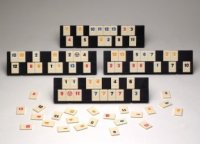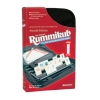Rummikub® Rules
 Rummikub® is a commercially-available tile rummy game developed by Israeli games inventor Ephraim Hertzano
in the early 1930s. Even though this game is played with tiles rather than cards, this is a true Rummy game,
featuring many of the elements common to all Rummy games, including the goal of making melds of three or more of a kind.
Rummikub® is a commercially-available tile rummy game developed by Israeli games inventor Ephraim Hertzano
in the early 1930s. Even though this game is played with tiles rather than cards, this is a true Rummy game,
featuring many of the elements common to all Rummy games, including the goal of making melds of three or more of a kind.
Rummikub is also known under other names, such as "Tile Rummy", "Rummy Tiles", "Rummy-O", "RummyCube", "Rummykub", "Rummicub", "Rummicube", and "Rummycub".
Here is an interesting theory about why tiles are used rather than cards:
Over the years, a number of different religious groups have associated playing cards with gambling, and have enforced a strict prohibition against all card games, regardless of whether they were gambling games or not. Rummikub arose as an alternative to this prejudice against playing cards. It is a purely numbered tile game with no images of kings & queens, or other royalty. Rummikub is considered by millions of lay men and women around the world, as socially relaxing and interactive play for all ages. Also clergymen and clergywomen of many denominations enjoy this peaceful and enjoyable game.
Rummikub Rules
Introduction:
All over the world people are discovering the joys of Rummikub® an exciting, fast-moving game which combines the element of luck with strategic planning to provide hours of fascinating play Rummikub° btings together the most popular features of a number of well-known pastimes including Mah-Jongg®, dominoes, rummy and even an element of chess, into a modern game which holds the attention, stimulates the imagination, challenges the wits and pleases the eye of today’s demanding game players.
How to Play Rummikub®,
The Sabra Way
RULES
SABRA WAY is played by 2, 3, or 4 people. It is played very much like cards except you play with tiles. There are 106 tiles in the game including 2 jokers.
There are 4 different color tiles, black, red, orange, and blue numbering 1 through 13.
The object of the game is to be the first to eliminate all the tiles from your rack by forming them into sets of runs and groups, and then melding them onto the table.
Your objective, therefore, is to keep as few points in your hand as possible.
SETTING UP THE GAME
Mix the tiles thoroughly face downward on the table. Each player picks a tile to see who goes first. The one who selects the highest tile is the first to play. The others follow going counterclockwise.
After you determine who plays first, all the players pick 14 tiles.
BEGINNING
In order to place tiles on the table each player must make an initial meld of 50 points in one or more sets. These points must come from tiles in the hand only and not from tiles already on the table. Each tile is worth the number of points as valued on the tile. A joker may be substituted for any tile and its point value is the same as the tile it represents when melding, and worth 30 points when held on your rack while another player wins.
RUNS
All runs must consist of at least 3 tiles of the same color -
EXAMPLES:4, 5, 6 red 1, 2, 3, 4 orange
GROUPS
Groups must consist of 3 or 4 tiles of different colors
EXAMPLE:#4 red, #4 blue, #4 black
Not acceptable: #4 orange, #4 orange, #4 red
MELDS
EXAMPLES:
A) #4 Blue Total 15 points
Joker (replacing #5 blue)
#6 Blue
B) #13 red Total 39 points
#13 orange
#13 black
C) #10 orange Total 33 points
#11 orange
#12 orange
PLAYING THE TABLE
Once you have placed your initial 50 points down, you are free to play on the table and manipulate and rearrange melds.
If you cannot add onto the other runs or groups of yours or opponents, you must pick a tile from the table. Then you must wait until your next turn to play. You continue to pick tiles until you are able to play - you can never lay down once you have pulled a tile.
EXAMPLE:
A) #4 orange
#4 black
#4 red
are on the table. You can add the #4 blue. You are, therefore, able to take on one of the #4’s to use for another group or run. You must leave at least 3 tiles in order to make another meld.
B) #6 red
#7 red
#8 red
are on the table. You can add either a #5 red or a #9 red. If you have a joker in your tiand you could make the following addition.
#4 red
Joker (substituting the #5 red)
#6 red
#7red
#8 red
If there are more than 3 tiles in one group or run, you can take the excess to make a new group or run. Each set must contain at least 3 tiles.
C) #6 blue
#7 blue
#8 blue
#9 blue
are on the table. You make take the #6 blue if you have a #5 and a #7 blue and make a new run. Or, if you have a #6 red and a #6 orange you can make a new group of #6’s. The same would apply to the #9 blue, you would still be leaving 3 tiles if you took either the 6 or the 9.
D) #5 red
#5 blue
#5 orange
#5 black
are on the table. You can take one of the 5’s and add it with a #4 and a #6 of the same color and make a run. Or if you had two more #5’s in your hand you could take a different color #5 and make another group.
E) #6 orange #9 red
#7 orange #9 blue
#8 orange #9 black
#9 orange
are on the table. If you have an 8 blue and 10 blue in your hand you can move the 9 orange over to the group of 9’s and then take the 9 blue for your run. Therefore, you are still leaving 3 in each set.
F) #1 blue #1 orange #1 red
#2 blue #2 orange #2 red
#3 blue #3 orange #3 red
#4 blue #4 orange
are on the table. If you have a #4 black in your hand and a #1 black you can use them to make the following groups.
#1 blue #2 blue #3 blue #4 blue
#1 orange #2 orange #3 orange #4 orange
#1 red #2 red #3 red #4 black
#1 black
THE JOKER
A Joker may be substituted for any tile when you make a meld. You can add a tile to a meld containing a Joker, either the fourth tile in a group or to either end of a run. You may not take a tile away from a meld which includes a Joker. You may take a Joker from a run or group in exchange for a tile of the same vaue from your hand. You must use the Joker immediately with 2 more tiles from your hand to make another meld onto the table. You may not hold the Joker to use ata later time. Under tournament rules, a Joker taken from a group of three tiles must be replaced with both missing tiles.
EXAMPLES:
A) #3 red #3 red Joker _
#4 red --> #4 red --> 8 black |_ From
Joker #5 red 8 orange _| Hand
or
B) #7 blue #7 blue Joker _
#7 red --> #7 red --> 8 black |_ From
Joker #7 orange 9 black _| Hand
#7 black #7 black
or (tournament play)
C) #3 red #3 red Joker _
#3 blue --> #3 blue --> 8 black |_ From
Joker #3 black 8 orange _| Hand
#3 orange
A meld containing a Joker may not be manipulated. After a Joker has been taken from a meld as shown above, the meld may be manipulated.
TIME LIMIT
Two minutes per turn - per player.
SCORING
Each loser adds up the value of the tiles left on his rack, counting 30 points for a joker and face value for all other tiles, and scores this as a minus (negative) amount.
The sum of all the losers’ scores is credited to the winner as a plus amount. At the end of the session, each player’s final score is totalled for the final results. The total of the plus scores should equal the total of the minus scores if all the arithmetic has been done correctly.
In the rare case that all the tiles are used up before anyone goes Rummikub®, the player with the lowest count remaining on his rack is considered the winner. Each of the losers adds up his total remaining tile value, subtracts the winner's total and scores the result as a minus amount, and the winner gets a plus score by totalling the losers’ scores.
PENALTIES
A player who plays past the two-minute time limit must draw one tile from the pool.
A player who manipulates the tiles unsuccessfuUy and leaves incomplete melds on the table, must replace the tiles in their original positions, take back the tiles he has melded, and draw three additional tiles from the pool.
© E. Hertzano, Israel, © 1985 Pressman Toy Corp., N.Y., N.Y.
Other Rummikub Rule Links
Other Rummy Tile Games
John McLeod has rules for several other related games, including the Turkish game Okey, Romanian Tile Rummy, and the Rummikub variations American Rummikub and International Rummikub.
Rummikub Card and Board Games
Rummikub Software
Rummikub® is a registered trademark of Pressman Toy Corporation. The Rummikub rules were OCR'd from a vintage rule sheet, and are provided as an educational resource for Rummy players, researchers, and students of the game. Any grammatical or typographical errors are an artifact of this process, and should not be attributed to the original source.













